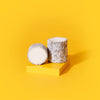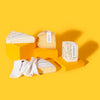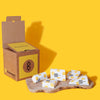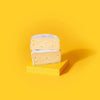Goat's Cheese Buyer's Guide
By Claragh Nugent
Oct 11, 2021

Goat’s cheese, or as some may call it 'Chèvre', which simply means Goat in French ( Don’t worry this isn't a French lesson) has some serious versatility from mild to mature and buttery to crumbly. It can be found on nearly every cheeseboard, in salads, tarts and pizza’s and comes from one of the oldest and simplest form of cheese making, seeing as goats were the first domesticated animals. In fact, it is presumed they were domesticated somewhere between 10,000 and 8500 B.C, roughly 1500 years before cattle.
First some FAQs on Goat’s Cheese.
When is Goat's Cheese Primarily produced?
Unlike Cows, Goats tend to produce their milk in Spring, so from March to around July, the highest quality cheese is made. During production the level of acidity is very carefully managed using certain amounts of starter culture which has the role of preparing the milk for the rennet. This enzyme, curdles the milk separating it into curds and whey. Younger Goat’s cheese have a paler colour such as Sinodun Hill or Driftwood, whereas more mature cheeses have a firmer, more distinctive yellow hue and a somewhat furred rind such as Holbrook.
How come some Goat’s Cheeses are Vegetarian?
It's well known that the popularity around a plant-based and vegetarian diet is multiplying each year, and going by our previous blog, many cheeses certainly can be vegetarian. The reason so many Goat’s Cheeses are vegetarian such as Tor and Golden Cross, is due to the fact that the rennet used does not come from the stomach of animals, but rather from plant-based enzymes that have their own coagulating properties. Vegetarian rennet's tend to produce flavours which are more compatible with the flavour profile of fresh goat's milk opposed to cow's milk, but of course this is simply a generalisation and not always the case. However, goat’s cheese is therefore more widely consumed around the World, compared to cow’s cheese which are more common in the Western World.
Why do the fats in Goat’s and Cow's milk make a difference?
Chances are, we don’t need to tell you what a Goat’s Cheese tastes like, but that earthy, tarty flavour needs to be addressed. The zesty tartness generally comes from the high content of caproic acid, which is a fatty acid specifically produced in Goat’s milk, giving it that ‘Goaty’ flavour. Although Goat’s milk is quite similar in relation to fat content when compared with Cow’s milk at 3.5%, Goat’s milk is easier to digest. This is primarily due to the fact Goat’s milk fat globules are 20% smaller than Cow’s and therefore are broken down easier, allowing for Goat’s milk to be a lot more suitable for those with lactose intolerance. Although none of us cheesegeek's are professional dieticians, so always make sure to check out what cheeses you can have with them, depending on your requirements.
So, here’s your gorgeous Goat’s Cheese buyer’s guide.
For the Milder Mates:
Ticklemore: Hailing from the Sharpham Estate in South Devon, it's light and delicate with super fresh and subtle flavours. You get a twang of lemon which is then offset by the the crumbly, chalky texture AND you get that lovely bloomy rind.
Sinodun Hill: A pyramid of beauty, Sinodun Hill is for both Goat's cheese lovers and newcomers alike. Under its velvety, golden cloak is hiding a silky smooth layer of pure decadence. Take off his layers and you'll unveil a centre of dense creamy mousse similar to...sweet ice cream.

For the Strong Supporters.
Golden Cross: Golden Cross is a great goat's cheese. Its dense and silky texture means it's super satisfying to chomp through. The flavours range from the subtle, floral, and grassy to more complex and intense as it becomes denser, creamier and full-flavoured with maturity
Driftwood: Forget tangy and crumbly, underneath the velvety rind, hides a smooth dense citrusy mousse. Cushioned with a rich silky breakdown of oozing creaminess, you get a perfect symphony of textures with a hint of lingering minerality from the ash-rolled rind.
For our Vegetarian Buddies.
Rachel: Rachel has an utterly divine supple moreish texture that you experience when you bite into it, leaving teeth marks...you know the one. Springy when you press it, it has the faintest hint of the usual goaty tang, but way more than that it is buttery, nutty, and slightly milky as opposed to being deeply creamy.
Tor: A charcoal dusting gives it a unique colouring with the cheese itself having a dense creamy texture and lemony undertones, without losing that classic goaty tang. Tor is a standout option, adding depth to any cheeseboard. It must be noted though that it is mild enough for even the most reluctant goat's cheese convert.










